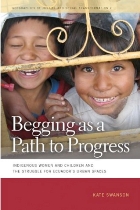Children’s Rights at a Cross-Roads
20th Anniversary of the United Nations Convention on the Rights of the Child: A global conference on research and child rights, Addis Ababa, Ethiopia, November 30 – December 2, 2009. ISYS Director Stuart Aitken will organize a two-day round-table discussion on “Young People’s Migration and Dislocation.”
Millions of children are victims of wars and poverty. The number of children denied their basic right to a life in dignity is alarming. The Millennium Development Goals on poverty and hunger, child health and universal education will not be met by 2015. This situation calls for better and more effective child rights policies. To contribute to this we need an academic community with a research agenda that relates to the global child rights situation and mechanisms for dialogue between policy making, practice and academia that promotes evidence based policies. The 20th Anniversary of the United Nations Convention on the Rights of the Child calls for critical reflection on the role of research in the realization of child rights.
(Conference info available at Child Watch website.)
Literature Review on Qualitative Methods and Standards for Engaging and Studying Independent Children in the Developing World
This paper by Stuart Aitken and Thomas Herman identifies and evaluates qualitative methods appropriate for use in conducting policy-relevant research on the experiences, motivations, agency and life histories of autonomous and semi-autonomous children and adolescents, including those who migrate independently of parents and adult guardians. First, the paper presents an overview of qualitative research practice and the potential for qualitative research to extend and deepen knowledge of children’s varied and independently negotiated life circumstances. It is argued that qualitative approaches are necessary to understand and meaningfully respond to the experiences of diverse physical, social and cultural environments. Research ethics are discussed from several points of view, highlighting both the importance of maintaining, and difficulty of defining, ethical engagement with subjects whose vulnerabilities and capabilities are manifest in ways that unsettle many traditional conceptions of children. The second, longer section of the paper presents illustrative examples of qualitative research techniques. An illustrated inventory of research tools is presented with seven categories: surveys; interviews and focus groups; observation and participant observation; life histories and biographical methods; visual and textual methods; performance, play and arts-based methods; and virtual and computer-aided methods. Particular attention is given to practical details of field research, including subject recruitment/sampling, research setting, facilitation of interaction with subjects through intermediary contacts and organizations, and the specific steps taken to collect qualitative data. The concluding section synthesizes the information presented and provides guidance on how to incorporate qualitative methods, and qualitative methodologies, into research on children who live independently of parents and adult guardians or who exercise autonomy in more limited contexts.
(Paper downloadable from UNICEF Innocenti Research Centre.)
Young People as Agents of Change: The Experiences of New Immigrant Families in a Border Community
This project examines how children and young people act as agents of change with regard to the community involvement and civic participation of new immigrant families in a suburb of San Diego, California. The goals of the project are to uncover different pathways and strategies that immigrant adults develop and follow as a result of their interaction with children and young people in their communities. By analyzing how young people exert a continual and subtle influence on the knowledge and perspectives of immigrant adult family members, this project will advance knowledge of the way immigrant families overcome barriers to assimilation and become involved in their communities. This project contributes to current scholarly and policy debates regarding the civic and community incorporation of immigrants in the contemporary United States.
An article published in the journal Gender, Place and Culture , “Women and children in a neighborhood advocacy group: engaging community and refashioning citizenship at the United States–Mexico border,” (by Fernando Bosco, Stuart Aitken, and Thomas Herman) is an outcome of this project and is accessible here.
Begging as a Path to Progress: Indigenous Women and Children and the Struggle for Ecuador’s Urban Spaces, by Kate Swanson, 2009. University of Georgia Press.
 This book challenges prejudices about the women and children who beg in Ecuadorian cities.
This book challenges prejudices about the women and children who beg in Ecuadorian cities.
In 1992, Calhuasi, an isolated Andean town, got its first road. Newly connected to Ecuador’s large cities, Calhuasi experienced rapid social-spatial change. Based on nineteen months of fieldwork, this study pays particular attention to the ideas and practices surrounding youth. While begging seems to be inconsistent with – or even an affront to – ideas about childhood in the developed world, the book demonstrates that the majority of income earned from begging goes toward funding Ecuadorian children’s educations in hopes of securing more prosperous futures. Examining beggars’ organized migration networks, as well as the degree to which children can express agency and fulfill personal ambitions through begging, the book argues that Calhuasi beggars are capable of canny engagement with the forces of change. It also shows how frequent movement between rural and urban Ecuador has altered both, masculinizing the countryside and complicating the Ecuadoran conflation of whiteness and cities. Finally, the study unpacks ongoing conflicts over programs to “clean up” Quito and other major cities, noting that revanchist efforts have had multiple effects – spurring more dangerous transnational migration, for example, while also providing some women and children with tourist-friendly local spaces in which to sell a notion of Andean authenticity.
(Available from Univ. of Georgia Press.)
